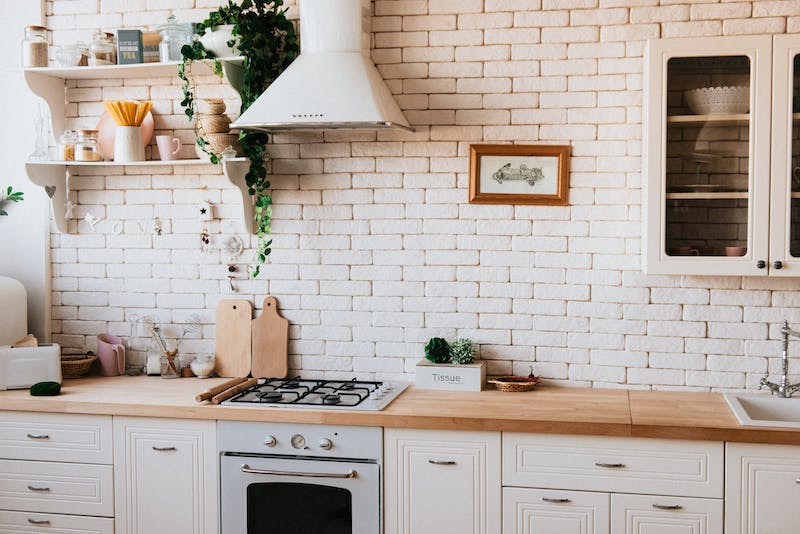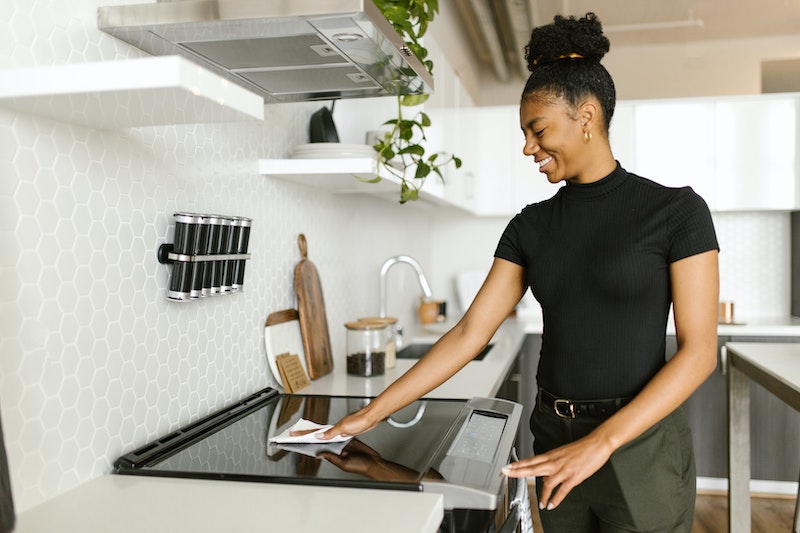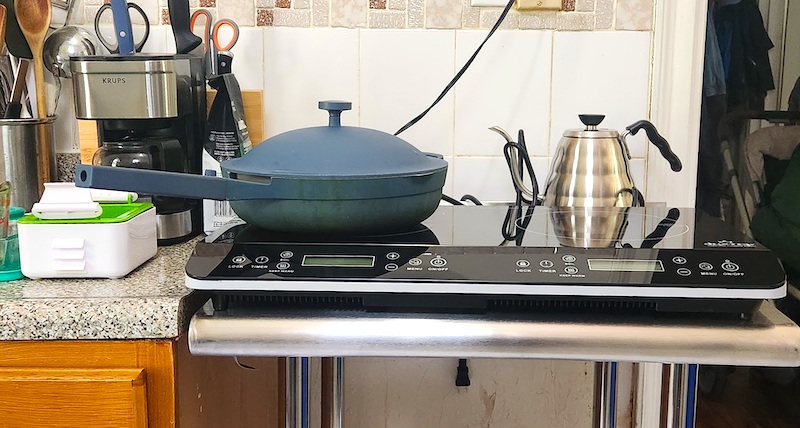So You Want to Ditch Your Apartment's Gas Stove?
It isn’t simple, but there are hacks. Here’s how.

It isn’t simple, but there are hacks. Here’s how.

You don’t have to be paranoid to suspect that the gas stove in your apartment might be having negative effects on your health.
There’s been a ton of reporting over the past year about this issue—as well as concerted pushback from the industry itself—all of which can leave renters feeling confused and anxious.
Who to trust? How worried should you be? And what can you actually do about it?
Concern about gas stoves in homes didn’t arise out of thin air over recent months.
But 2022 and 2023 have brought a slew of in-depth reporting and studies that highlight both the environmental impact of gas stoves, as well as the potential health concerns for people living with the appliances—especially in homes that don’t offer appropriate ventilation.

Some sources suggest that gas stoves also put out harmful indoor emissions even when you’re not actively using them, and are also a source of benzene, a carcinogen.
We’re certainly not going to get to the bottom of the issue here, and we’re not scientists ourselves. If you’re interested in investigating some of the more comprehensive reporting, the links below are a great place to start.
This reporting has caused renewed public conversation around the issue of gas stoves, and in some cases has even led to palpable political action—including a ban on gas stoves in new residences in New York state that kicks in by 2026.
The TLDR here is that removing a gas stove and replacing it with an electric one can be super expensive, and borderline impossible in some cases. If you’re a renter, you’re also at the mercy of what your landlord or management company wants to do.
It’d be nice if making the swap was as simple as carting away your gas-based appliance, purchasing an electric range, and plugging it into the wall. But electric ovens use a tremendous amount of energy and there are technical to considerations, such as:

Don’t go spelunking in your building’s basement on your own. In fact, don’t do anything on your own—loop your landlord or property management into the conversation, and work with experts. Explain your concerns to your landlord, and ask if there’s a way to potentially support an electric oven that would require 240-volts.
If your building is older, it’s possible that the answer is “Hell no,” or “No, not without spending thousands and thousands of dollars.” There’s no law requiring landlords to make these changes (yet), so it’s unlikely that you’ll have much success in these cases.
If your building can indeed support the conversions required to install an electric range in your apartment, start a frank conversation with your landlord or management company.
Explain the benefits of switching to an electric stove—it might make the unit more tempting for health-conscious renters in the future—and perhaps offer to split or share the costs involved.
If you’re willing to spend a bit of money and get creative, you can replace your gas stove with individual appliances that don’t require a major reimagining of your building’s electric grid.
Full disclosure: I was in this exact position several months ago. Nervous about the health risks of my gas stove, especially with a toddler in the house; stuck with the limitations of my semi-ancient Brooklyn building, whose electrical system couldn’t be easily converted to power a proper electric stove.
There’s no one-size-fits-all solution, and there are multiple ways to cobble together a system of appliances to replace your gas range. That said, here’s how I did it, if you’d like to copy the process.
There is hope if you’d like to assemble an alternative to your gas range (and no, the answer isn’t “just microwave everything, forever.”)
Repeat after me: You’ll need your landlord for this! Like any substantive change to your apartment, you need the approval of your building’s owner. After all, the gas stove most likely belongs to your landlord, not you.
If your landlord agrees, though, it should be fairly simple for them to have someone de-install and remove the existing gas stove. A professional should also “cap” the gas line itself, to prevent any emission leaks.
A high-quality electric range can perform just as well as a gas stove can (and even better, if your gas stove was a cheap piece of crap, like mine was).
You’ll want to make sure that the range you’re purchasing doesn’t require 240 volts to operate. I went with this two-burner option from Duxtop, around $230 at the time of writing.
This is an induction burner, which has its benefits, but also requires certain types of pots and pans to work. The simplest test involves a magnet: If a magnet sticks to the bottom of your cookware, it’ll work with induction.
Removing your original gas stove will leave…well…a gas stove-shaped hole in your kitchen. If you’ve already got tons of counter space, this might be no problem—it could provide an extra area for cabinets, a spice rack, or whatever you like.
What I did was fill the space with a restaurant-grade stainless steel shelf that gave me surface area to put the Duxtop electric range on top of (along with some shelving underneath for pots and pans).
These shelving units come in various dimensions, so if you’re lucky, you’ll be able to find one that fits the footprint of the former gas stove, and is also level with your existing countertops. Some might call it DIY, but I prefer…industrial chic?

There’s a wide range of electric cooking appliances that can help replace the functionality of your former gas stove.
Is the system described above as convenient as having a proper electrical stove in your apartment? Nope. But it’s not a bad hack, especially if you’re willing to suffer a bit of annoyance in order to quit worrying about what your gas stove might be doing to your health.
My current kitchen set-up can leave me feeling a bit like a domestic DJ. There’ll be something simmering on the electric range, frozen peas cooking in the microwave, a tray of new potatoes ready to be popped into the toaster oven—you get the idea.
Even though these appliances aren’t all plugged into the same outlet, they can blow circuits if I’m not careful. This requires a bit of trial and error. If I’m boiling water on the Duxtop range, I might be able to run the toaster oven simultaneously at 350 degrees—but if I crank it up to 425, forget about it.
Best of luck with leaving your gas stove behind. But if this process seems insurmountable, or too expensive, or too headache-inducing…don’t despair!
First, consider basic things you can do to improve the air quality in your apartment overall, like:
That should give you at least a little more peace of mind.
And speaking of peace of mind—see what we did there?—consider how renters insurance can protect all the stuff you care about.
The national average for Lemonade Renters is around $14/month, and that goes a long way toward helping you dodge the curveballs life as a renter can throw at you. Plus, we’re doing our own part to work toward cleaner energy and a better environment, thanks to our Giveback program and our stance on coal investments.
A few quick words, because we <3 our lawyers: This post is general in nature, and any statement in it doesn’t alter the terms, conditions, exclusions, or limitations of policies issued by Lemonade, which differ according to your state of residence. You’re encouraged to discuss your specific circumstances with your own professional advisors. The purpose of this post is merely to provide you with info and insights you can use to make such discussions more productive! Naturally, all comments by, or references to, third parties represent their own views, and Lemonade assumes no responsibility for them. Coverage may not be available in all states.
Please note: Lemonade articles and other editorial content are meant for educational purposes only, and should not be relied upon instead of professional legal, insurance or financial advice. The content of these educational articles does not alter the terms, conditions, exclusions, or limitations of policies issued by Lemonade, which differ according to your state of residence. While we regularly review previously published content to ensure it is accurate and up-to-date, there may be instances in which legal conditions or policy details have changed since publication. Any hypothetical examples used in Lemonade editorial content are purely expositional. Hypothetical examples do not alter or bind Lemonade to any application of your insurance policy to the particular facts and circumstances of any actual claim.